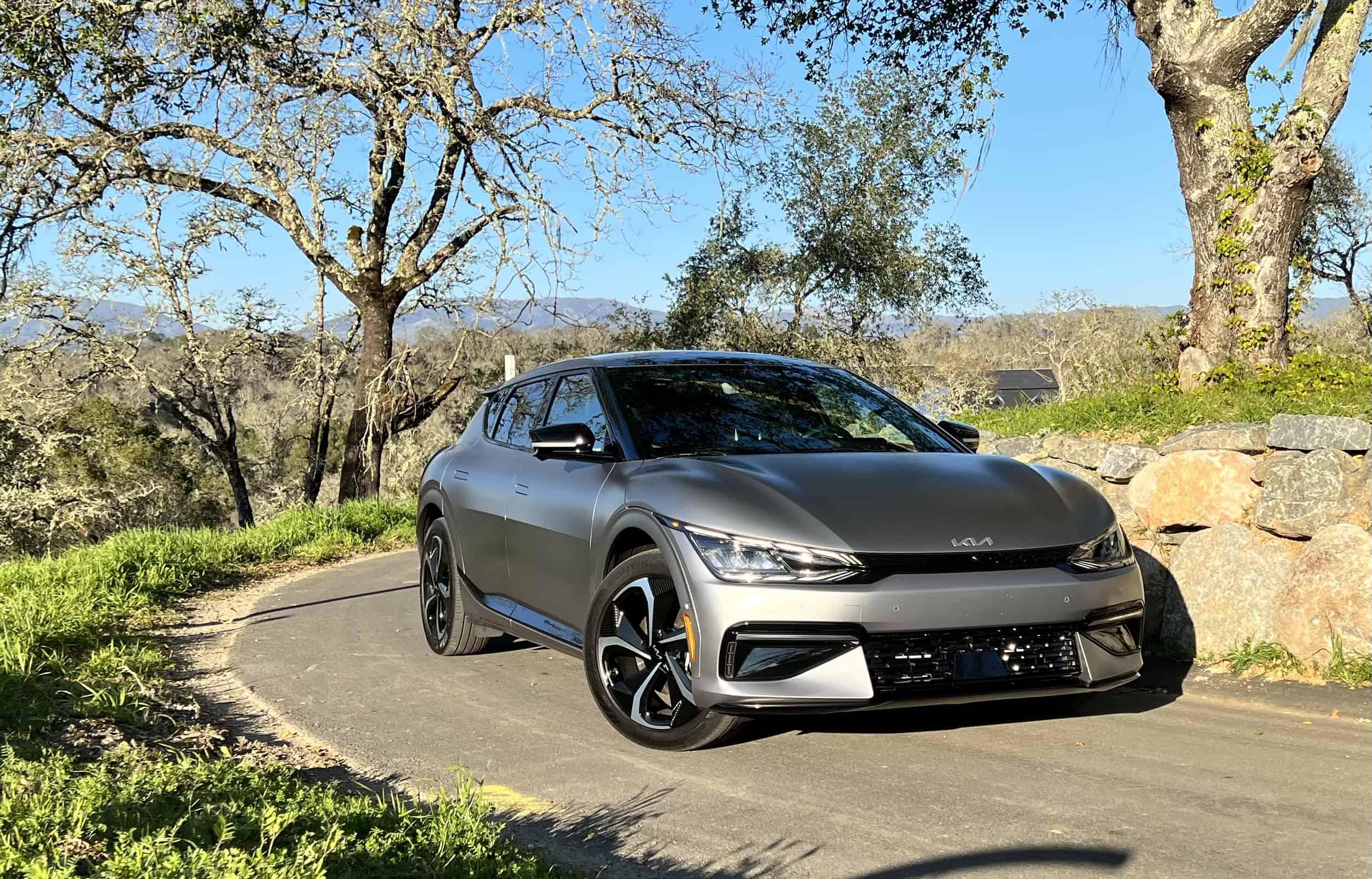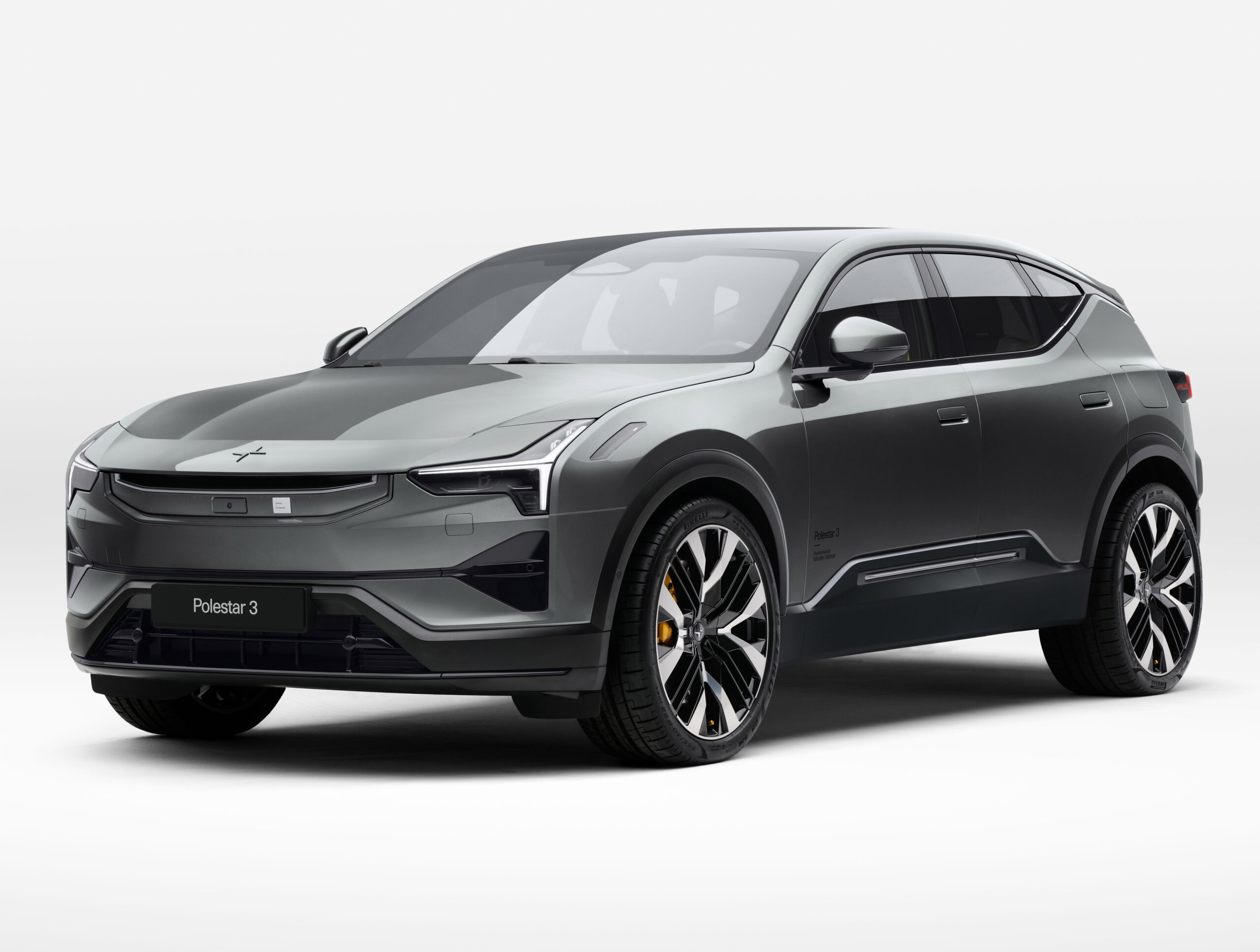

Kia’s EV6 isn’t the brand’s first EV, but it is arguably its most important. The EV6 is the start of an onslaught of new electric vehicles designed to compete directly with the best in the world under the names “EV#”. Kia has pledged that 40% of their vehicles will be electric by 2030 and 100% by 2040, quite a tight schedule. To meet the mark, Kia needs to start 2022 with a winner. That winner is the EV6.
The design of the EV6 is striking, and that’s exactly what keeps shoppers interested. With the design constraints of an ICE platform cast off, Kia opted to take the E-GMP platform shared with Genesis and Hyundai and create something decidedly futuristic. The result is an extreme cab forward profile with short overhangs, a long wheelbase and a low slung hood. Tesla and Mach E fans will likely be sad to hear that the size and shape of the front end precluded any sizable cargo area underneath.

For some of the EV faithful, the lack of a front trunk is treated as “lazy design”, but I don’t buy it. In order to give the Model 3 or Mach E a front trunk, the engineers had to design the car as if it were a traditional car with a big engine in front. If you’re designing a new EV, why make the front end capable of holding a 6.0L V8? Don’t get me wrong, I love a cargo area up front, but is it a deal breaker? I don’t think so, but if you do, this EV isn’t for you.

The most controversial styling happens in the rear where a huge LED bar is stretched from one wheel arch to the other across the rear hatch. As you’ll see in the video link posted above, the bar has a great deal of surface texture and looks very impressive in person from a design perspective, but it is certainly a love-it-or-hate-it choice. A little less noticeable in pictures, the greenhouse pinches in towards the rear giving the body a distinct bell shape and powerful haunches, regrettably cutting into rear seat and cargo space, however.

Under the skin, the EV6 shares most of its components with the IONIQ 5 and the upcoming GV60, but there’s a twist. Somehow Kia managed to convince the corporate overlords that they should be the one to flagship a new dual-motor 576 horsepower system later this year. Aside from that, the rest is basically the same as the boxy IONIQ 5.
Base models get a single rear electric motor good for a rather yawn-inducing 167 horsepower and 258 lb-ft of torque from a 58 kWh battery with 232 miles of range. Kia didn’t provide a 0-60 estimate… but expect it to be glacial. There’s a reason Kia didn’t have any base trims to sample at the launch events. The main reason the “Light” EV6 trim exists is to replace the Niro EV in the lineup as an affordable alternative with a staring price under $41,000 before the federal tax credit. One thing to note, however, is that a second generation Niro does exist and should be coming to the U.S. by early 2023.
I suspect most people will be interested in the Wind and GT Line trims, which both use the same 77.4 kWh battery and bump range to 310 for the RWD model and 274 if you opt for the dual-motor AWD system. All versions with the bigger battery use the same 225 horsepower electric motor in the rear capable of 258 lb-ft. of torque. AWD models get a second electric motor in the front cranking out 95 horsepower and 188 lb-ft of twist for a total of 320 ponies and 446 lb-ft. To help improve parts commonality, the front and rear motors are identical at their core, though power control hardware and the differentials are different. The rear uses a typical single speed reduction gear and open differential while the front uses a mechanical axle disconnect. This feature is similar to the axle disconnects we see on some 1/2 ton trucks and the function is the same: reducing mechanical losses when power to the front isn’t needed.
I wouldn’t normally discuss drive modes but I’ll do it here for an important reason. Kia decided that in AWD models the “Eco” mode should disable the front motor even when the accelerator pedal is pushed to the floor. A unique choice, the car’s max output in this mode is 225 horsepower, but efficiency is preserved. Normal mode will bias power to the front upon launch from a stop then disconnect the front in steady state driving for greater efficiency. Snow and Sport modes bias power 50/50 from 1 to 190 total system horsepower for a more balanced feel. Even at steady speeds the front axle is always connected and functioning.

You’ll find the J1772 and CCS charge connector on the back of the EV6 just under the passenger side tail lamp module. The power door is touch activated but lacks the situational awareness found in Tesla’s automated charge doors (in other words, it won’t open for you because you parked at a charging station or pulled into your garage). The onboard AC charger supports up to 10.9 kW charging when connected to an EVSE that supports 48 amp charging.
The CCS connector allows one of the fastest charging rates on a new EV: 10-80% in just 18 minutes. This is thanks to a smaller pack than you’ll find in a Mach-E and one of the highest peak and sustained charging curves in the biz. The EV6, like the IONIQ 5, will peak at 260 kW and average nearly 160 kW across the average charging session. Even more impressive for road trippers, the EV6 can gain a 100% charge from near-zero in the same amount of time it takes a Mach E to get a 70% top-up.
The fast charge rates are all thanks to the 800V pack design, one of the first like it in the world. Remember that current and voltage can be like a sea-saw. Double one and you get to half the other for the same power delivery. 800V charging means that for a similar peak rate on a Tesla Model 3, the connectors in the EV6 are only handling half the current. This reduces weight, the need for conductor cooling, etc. Making it backwards compatible with 400V chargers can be tricky, but Kia’s solution here is elegant as well. Rather than a separate DC-DC converter like we find in the Taycan, Kia integrates that into the rear motor inverter for greater efficiency and lower costs. Kia didn’t give us a spec for the DC-DC conversion rate, but sister-company Hyundai said it will “support the fastest 400V charging rates in the USA.” Sounds like we need to test that.

The exterior design is certainly a departure for the brand most associated with their “tiger nose grille” and the boxy Telluride, but the interior is more evolution for Kia than revolution. The 12.3 inch instrument cluster features a new look as does the 12.3-inch standard infotainment system, but the underlying software is the same as most Kias on sale today. That means the infotainment software is intuitive, attractive, and features full-screen CarPlay integration, however wireless CarPlay is still missing with this screen for some reason.
Dashboard and door components are made mainly from soft touch materials and as with most EVs, Kia would like you to know that there is a large percentage of recycled and recyclable materials in use. The two-spoke steering wheel might make some folks look twice, especially since I don’t recall any similar design that also had a flat bottom design, but it’s comfortable and does its job well.
Front seat comfort was above average during the day I spent with the EV6 and I appreciated the tilting seat bottom cushion that for some reason our long-term Mach E lacks.Combined legroom is a generous 81.4 inches, identical to the Ford and ahead of most of the alternatives save the Model Y. Unfortunately due to the curvaceous design and Kia’s rare (in the EV world) decision to have the moonroof actually open, headroom is at a premium. Less obvious by the numbers is the somewhat narrow greenhouse that results in less room between your noggin and the door sill. This is noticeable in both rows but more so in the rear.

After a series of perfectly rational but not terribly exciting EVs, Kia decided to take a different course with the EV6. Models with the big battery and RWD get 235-width 19 inch tires, while AWD trims upgrade to standard 255/44R20s. It’s worth noting that this isn’t even the full-on GT model, and yet you already get wider tires than any Mustang Mach-E, including the GT Performance. Tire size is suspiciously similar to a non-performance Model Y, however. Thanks to a well-tuned suspension, lower curb weight than the Mustang’s, and the wide tires, grip is impressive for a modern mid-market EV. It’s no Taycan, but it’s certainly a notch above the Ford even without performance tires. Also surprising is the ride quality. Although firmer than the IONIQ 5’s, the EV6 avoids the “firm and bouncy” feel pioneered by Tesla with the Model 3 and Model Y and imitated to perfection by Ford for the Mach-E.
0-60 times were equally impressive. Although I was unable to test the EV6 models directly, I got to share cars with Redline Reviews and did the test with Sofyan’s Racebox equipment. The AWD model shot to 60 in 4.6 seconds while the RWD model dropped things down to 6.8. Those numbers are notably swifter than Volkswagen’s dual-motor ID.4 and a hair better than the Mach-E dual motor “Premium” trim on the same surface. It’s critical to remember that in an EV, 0-60 isn’t just about peak power, it’s also about how short the “ramp” in power is. Dial in all 446 lb-ft. of torque from a stop, something a motor is certainly capable of, and you’ll end up with more slip than you can manage, more stress on driveline components, and more warranty claims for the manufacturer. Dial in the power too slowly and you have, well, an ID.4 which doesn’t let the power come to a boil until around 35 MPH which is why the 0-60 times are less exciting than most despite a good amount of power on paper.
So the EV6 rides well, accelerates like a base Model Y, and handles a winding road like a champ, but what about efficiency? Kia seems to have done their homework in this area as well. When equipped with either battery, RWD versions eek their way onto the EPA’s top 10 list for fuel economy at 117 MPGe, a list dominated by Tesla and Lucid at the moment. Choosing the dual-motor model drops the figure down to 105 MPGe, still a respectable result and the reason the EV6 nearly matches the 2022 Mach-E’s 277 mile range number, despite having a battery just 83% the size. That means not only will the Kia cost you less to run, it’ll also gain miles of range faster when charging at the same rate.

Starting at $40,900 plus a $1,215 destination charge, the EV6 isn’t a bargain basement EV, but it does undercut many of the competition, especially when you consider that the vast majority of EV shoppers will qualify for the full $7,500 tax credit. Something you don’t get on a new Tesla or GM EV since their credit allotment has been consumed (note: Ford may also be out of credits by late 2022). Sometimes it pays to be late to the party. Thanks to the credit, the base model drops to $34,216 before any additional state and local incentives. The motor output might not be exciting, but being nearly $25,000 less than a Model Y is likely to excite someone. A better comparison for the base model is the ID.4 from Volkswagen which is a hair less expensive. The VW is a hair more powerful, roomier, and more traditionally styled while the EV6 is for someone interested in sharper handling and a sharper style.
The least expensive model with 310 miles of range and the 225 HP motor is the EV6 Wind which starts at $47,000, to which you can add AWD for $3,900. In addition to extra traction, AWD adds 20 inch wheels, 255-width tires, a heat pump for lower energy consumption in the winter, a heated steering wheel, and heated rear seats. That price tag puts it ahead of the least expensive AWD Mach-E, but around $8,000 less than the big-battery Ford with comparable range. That may also be more dough than the ID.4 AWD, but the EV6 is better equipped and has a longer range.

In many ways, the Mach-E and the Model Y are the closest competitors to the new EV6 in terms of range, acceleration, and styling. The EV6 beats them all in the styling department, as long as you’re a fan of the design, while the Mach-E pictured above splits the pack with its controversial electric pony theme. The Model Y plays it safe with a nondescript front end and more classic luxury wagon proportions. If you’re shopping for one of the best EVs in America under $60,000, the EV6 should be on your list as long as you don’t need a huge trunk. Kia’s blend of style, performance, and cutting-edge drivetrain tech put it ahead of the Mach E for me at the moment, even considering that the excellent Mach-E GT exists. If you have high expectations for the EV6 GT coming later this year, trust me, you’re not alone.



